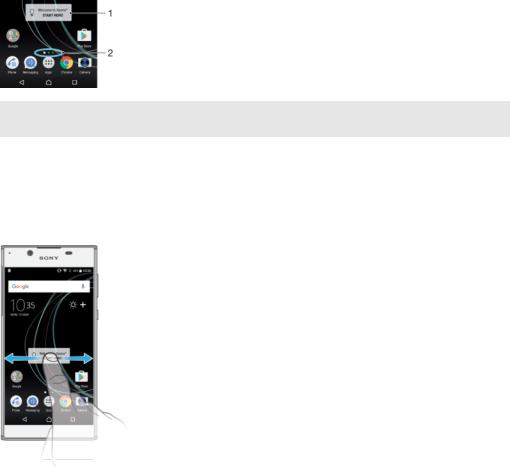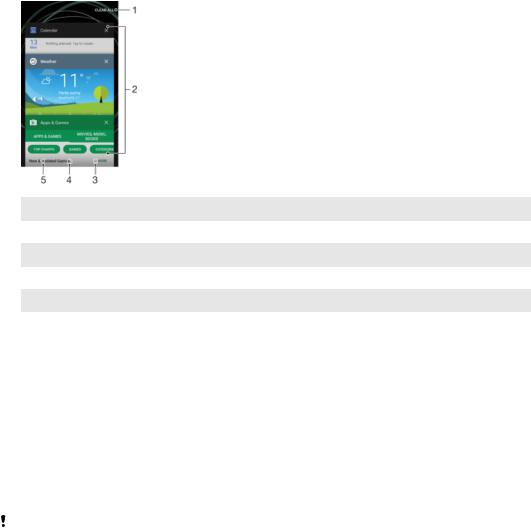Sony G3311, G3313 Operating Instructions

User guide
Xperia™ L1
G3311/G3313
Contents |
|
Getting started............................................................................... |
6 |
About this User guide........................................................................ |
6 |
Overview............................................................................................ |
6 |
Assembly........................................................................................... |
7 |
Screen protection............................................................................... |
8 |
Starting your device for the first time................................................. |
8 |
Why do I need a Google™ account?................................................. |
9 |
Device security............................................................................. |
10 |
Making sure your device is protected.............................................. |
10 |
Screen lock...................................................................................... |
10 |
Unlocking your device automatically............................................... |
11 |
SIM card protection......................................................................... |
15 |
Finding the identification number of your device............................. |
15 |
Finding a lost device ....................................................................... |
16 |
Learning the basics...................................................................... |
18 |
Using the touchscreen..................................................................... |
18 |
Locking and unlocking the screen................................................... |
19 |
Home screen.................................................................................... |
20 |
Application screen........................................................................... |
21 |
Navigating applications.................................................................... |
23 |
Widgets............................................................................................ |
24 |
Shortcuts and folders...................................................................... |
25 |
Background and themes.................................................................. |
25 |
Taking a screenshot......................................................................... |
26 |
Notifications..................................................................................... |
26 |
Icons in the status bar..................................................................... |
29 |
Applications overview...................................................................... |
30 |
Battery and maintenance............................................................. |
33 |
Charging your device....................................................................... |
33 |
Battery and power management..................................................... |
34 |
Updating your device....................................................................... |
36 |
Maintenance using a computer....................................................... |
37 |
Storage and memory....................................................................... |
38 |
Backing up and restoring content.................................................... |
40 |
Downloading applications............................................................ |
43 |
Downloading applications from Google Play™............................... |
43 |
Downloading applications from other sources................................ |
43 |
Internet and networks.................................................................. |
44 |
Browsing the web............................................................................ |
44 |
2
Internet and MMS settings ............................................................. |
44 |
Wi-Fi................................................................................................. |
45 |
Sharing your mobile data connection.............................................. |
47 |
Controlling data usage..................................................................... |
48 |
Selecting mobile networks............................................................... |
49 |
Virtual private networks (VPNs)........................................................ |
50 |
Synchronising data on your device.............................................. |
51 |
Synchronising with online accounts................................................ |
51 |
Synchronising with Microsoft® Exchange ActiveSync®................. |
51 |
Basic settings............................................................................... |
53 |
Accessing settings........................................................................... |
53 |
Volume settings................................................................................ |
53 |
Do not disturb mode........................................................................ |
54 |
Screen settings................................................................................ |
55 |
Application settings......................................................................... |
56 |
Resetting your applications............................................................. |
58 |
Screen saver.................................................................................... |
58 |
Language settings............................................................................ |
59 |
Date and time................................................................................... |
59 |
Enhancing the sound output............................................................ |
60 |
Multiple user accounts..................................................................... |
60 |
Typing text.................................................................................... |
63 |
On-screen keyboards...................................................................... |
63 |
Editing text....................................................................................... |
64 |
Calling.......................................................................................... |
65 |
Making calls..................................................................................... |
65 |
Receiving calls................................................................................. |
66 |
Ongoing calls................................................................................... |
67 |
Using the call log............................................................................. |
67 |
Forwarding calls............................................................................... |
68 |
Restricting calls................................................................................ |
68 |
Multiple calls.................................................................................... |
69 |
Conference calls.............................................................................. |
70 |
Voicemail.......................................................................................... |
70 |
Emergency calls............................................................................... |
70 |
Contacts....................................................................................... |
72 |
Searching and viewing contacts...................................................... |
72 |
Adding and editing contacts............................................................ |
73 |
Transferring contacts....................................................................... |
74 |
Backing up contacts........................................................................ |
75 |
Adding medical and emergency contact information...................... |
75 |
Favourites........................................................................................ |
76 |
3
Sending contact information............................................................ |
76 |
Avoiding duplicate entries in the Contacts application................... |
77 |
Messaging and chat..................................................................... |
78 |
Reading and sending messages...................................................... |
78 |
Organising your messages.............................................................. |
79 |
Calling from Messaging................................................................... |
79 |
Messaging settings.......................................................................... |
80 |
Video chat........................................................................................ |
80 |
Email............................................................................................. |
81 |
Setting up email............................................................................... |
81 |
Sending and receiving email messages........................................... |
81 |
Organising your email messages..................................................... |
82 |
Email account settings..................................................................... |
83 |
Gmail™............................................................................................ |
83 |
Music and FM radio..................................................................... |
85 |
Transferring music to your device.................................................... |
85 |
Listening to music............................................................................ |
85 |
Music menu..................................................................................... |
87 |
Playlists............................................................................................ |
87 |
Sharing music.................................................................................. |
88 |
Enhancing the sound....................................................................... |
88 |
Listening to the radio....................................................................... |
88 |
Favourite radio channels.................................................................. |
90 |
Radio sound settings....................................................................... |
90 |
Camera......................................................................................... |
91 |
Taking photos and recording videos................................................ |
91 |
General camera settings.................................................................. |
92 |
Still camera settings......................................................................... |
95 |
Video camera settings..................................................................... |
97 |
Photos and videos in Album........................................................ |
99 |
Viewing photos and videos.............................................................. |
99 |
Album home screen menu............................................................. |
100 |
Sharing and managing photos and videos.................................... |
101 |
Editing photos with the Photo editor application........................... |
102 |
Editing videos with the Video editor application............................ |
102 |
Hiding photos and videos.............................................................. |
103 |
Viewing your photos on a map...................................................... |
103 |
Videos......................................................................................... |
105 |
The Video application.................................................................... |
105 |
Transferring video content to your device..................................... |
106 |
Managing video content................................................................ |
106 |
4
Connectivity............................................................................... |
107 |
Displaying files on another device using Cast............................... |
107 |
NFC................................................................................................ |
107 |
Bluetooth® wireless technology.................................................... |
109 |
Smart apps and features that save you time............................. |
112 |
Google Search & Now.................................................................... |
112 |
Using your device as a wallet........................................................ |
112 |
Travel and maps......................................................................... |
113 |
Using location services.................................................................. |
113 |
Google Maps™ and navigation..................................................... |
113 |
Using data traffic when travelling.................................................. |
114 |
Airplane mode................................................................................ |
114 |
Clock and Calendar.................................................................... |
115 |
Calendar......................................................................................... |
115 |
Clock.............................................................................................. |
115 |
Accessibility............................................................................... |
118 |
Magnification gesture.................................................................... |
118 |
Font size......................................................................................... |
118 |
Display size.................................................................................... |
118 |
Colour correction........................................................................... |
118 |
TalkBack......................................................................................... |
118 |
Mono audio.................................................................................... |
119 |
TTY (Teletypewriter) mode............................................................. |
119 |
Switch Access............................................................................... |
119 |
Support and legal....................................................................... |
121 |
Support application....................................................................... |
121 |
Xperia™ Tips.................................................................................. |
121 |
Help in menus and applications..................................................... |
121 |
Running diagnostic tests on your device....................................... |
121 |
Restarting, resetting and repairing................................................. |
121 |
Help us improve our software........................................................ |
123 |
Warranty, SAR and usage guidelines............................................. |
123 |
Recycling your device.................................................................... |
123 |
Legal information........................................................................... |
123 |
5

Getting started
About this User guide
This is the Xperia™ L1 User guide for the Android™ 7.0 software version. If you're not sure which software version your device is running, you can check it in the Settings menu.
System and application updates can present the features in your device in another way than described in this User guide. The Android™ version might not be affected in an update. For more information about software updates, see Updating your device on page 36.
To check the current software version of your device
1From your Home screen, tap .
2Find Settings > About phone > Android™ version.
To find the model number and name of your device
1 From your Home screen, tap .
2Find and tap  .
.
The device model number and name are displayed.
Limitations to services and features
Some of the services and features described in this User guide may not be supported in all countries or regions, or by all networks or service providers. The GSM International Emergency Number can always be used in all countries, regions, networks and by all service providers, provided that the device is connected to the mobile network. Please contact your network operator or service provider to determine the availability of any specific service or feature and whether additional access or usage fees apply.
The use of certain features and applications described in this guide may require access to the internet. You may incur data connection charges when you connect to the internet with your device. Contact your wireless service provider for more information.
Overview
6
This is an Internet version of this publication. © Print only for private use.

1. |
Charging/Notification light |
10. |
Charger/USB Type-C™ cable port |
2. |
Headset jack |
11. |
Speaker |
3. |
Front camera lens |
12. |
Wi-Fi/GPS/Bluetooth antenna area |
4. |
Auxiliary microphone |
13. |
Main camera lens |
5. |
Ear speaker |
14. |
Flashlight |
6. |
Proximity/Light sensor |
15. |
Nano SIM/Memory card slot cover |
7. |
Volume key |
16. |
NFC™ detection area |
8. |
Power key |
17. |
Main antenna area |
9. |
Main microphone |
|
|
Assembly
Your device only supports nano SIM cards. The nano SIM card and the memory card have separate slots in the same holder. Make sure you don’t confuse the two.
To prevent data loss, make sure you turn off your device or unmount the memory card before you drag out the holder to remove the nano SIM card or memory card from the device.
To insert the nano SIM card and the memory card
Do not cut your SIM card, for example using a blade or scissors, as this may damage your device.
1Open the nano SIM/Memory card slot cover.
2Using your fingernail, drag out the nano SIM card tray.
3Firmly place the SIM card in the correct orientation as shown in the illustration.
4Insert the memory card in the correct orientation into its slot as shown in the
illustration.
5Gently push the tray back into the slot until it fits into place.
7
This is an Internet version of this publication. © Print only for private use.

To remove the nano SIM card
1Turn off your device.
2 With the screen facing down, open the nano SIM/Memory card slot cover.
3Drag out the nano SIM card tray using your fingernail.
4Remove the nano SIM card, then gently push the tray back into the slot until it fits into place.
5Close the nano SIM/Memory card slot cover.
To remove a memory card
1Turn off your device.
2With the device facing down, open the nano SIM/Memory card slot cover.
3Gently push in the memory card to release it from its slot. Remove the memory card and close the nano SIM/Memory card slot cover.
Screen protection
Before using your device, remove the protection film by pulling up on the protruding tab.
Screen covers and protectors may help you protect your device against damage. We recommend you use only those screen covers intended for your Xperia™ device. The use of third party screen protection accessories may prevent your device from working correctly by covering sensors, lenses, speakers, or microphones and can invalidate the warranty.
|
Starting your device for the first time |
|
It is recommended that you charge the battery for at least 30 minutes before starting |
|
up your device for the first time. You can still use your device while it is charging, see |
|
Charging your device on page 33. |
|
The first time you start your device, a setup guide helps you to configure basic |
|
settings, personalise your device and sign in to your accounts, for example a |
|
Google™ account. |
|
To turn on the device |
1 |
Press and hold down the power key until the device vibrates. |
2 |
Enter your SIM card PIN when requested, then tap . |
3Wait a moment for the device to start.
|
Your SIM card PIN is initially supplied by your network operator, but you can change it later |
|
from the Settings menu. To correct a mistake made while entering your SIM card PIN, tap . |
|
To turn off the device |
1 |
Press and hold down the power key until the options menu opens. |
2 |
In the options menu, tap Power off. |
It may take a while for the device to shut down.
8
This is an Internet version of this publication. © Print only for private use.

Why do I need a Google™ account?
Your Xperia™ device from Sony runs on the Android™ platform developed by Google™. A range of Google™ applications and services is available on your device when you purchase it, for example, Gmail™, Google Maps™, YouTube™ and the Play Store™ application, which gives you access to the Google Play™ online store for downloading Android™ applications. To get the most out of these services, you need a Google™ account. For example, a Google™ account enables you to do all of the following:
•Download and install applications from Google Play™.
•Synchronise your email, contacts and calendar using Gmail™.
•Chat with friends using the Duo™ application.
•Synchronise your browsing history and bookmarks using the Google Chrome™ web browser.
•Identify yourself as the authorised user after a software repair using Xperia™ Companion.
•Remotely find, lock or clear a lost or stolen device using the my Xperia™ or Android™ Device Manager services.
For more information about Android™ and Google™, go to http://support.google.com.
It is crucial that you remember your Google™ account username and password. In some situations, you may need to identify yourself for security reasons using your Google™ account. If you fail to give your Google™ username and password in such situations, your device is locked. Also, if you have more than one Google™ account, make sure to enter the details for the relevant account.
To set up a Google™ account on your device
1From your Home screen, tap .
2Find and tap Settings > Accounts & sync > Add account > Google.
3Follow the registration wizard to create a Google™ account, or sign in if you already have an account.
You can also sign in to or create a Google™ account from the setup guide the first time you start your device. Alternatively, you can go online and create an account at www.google.com/accounts.
To remove a Google™ account
1From your Home screen, tap .
2Tap Settings > Accounts & sync > Google.
3 Select the Google™ account that you want to remove.
4Tap > Remove account.
5Tap Remove account again to confirm.
If you remove your Google™ account, any security features that are linked to your Google™ account will no longer be available.
9
This is an Internet version of this publication. © Print only for private use.

Device security
Making sure your device is protected
Your device includes several security options, strongly recommended in case of loss or theft.
These options are as follows:
•Set a secure screen lock on your device using a PIN, password or pattern to prevent anyone from accessing or resetting your device.
•Add a Google™ account to prevent others from using your device if it gets stolen or wiped.
•Activate either the “Protection by my Xperia” or the Android™ Device Manager web service. Using one of these services, you can remotely locate, lock or clear a lost device.
Verifying the ownership of your device
Certain protection features require you to either unlock your screen with your PIN, password, pattern, or enter your Google™ account information. Below are examples of protection features and their required credentials:
Factory Data Reset protection
Protection by my Xperia
You must unlock your screen before you are allowed to perform a Factory Data Reset.
If you remotely reset your device using this service, you must enter the username and password for a Google™ account associated with the service. The device must be connected to the internet before the setup process can be completed. Otherwise, you will not be able to use your device after the reset.
Android™
Device
Manager
If you remotely reset your device using this service, you must enter the username and password for a Google™ account. The device must be connected to the internet before the setup process can be completed. Otherwise, you will not be able to use your device after the reset.
Software repair You must enter your Google™ account username and password when you start the device after the repair is complete.
For Android™ Device Manager, it is necessary to enter information from a Google™ account. This can be any Google™ account which you have set up on the device as an owner. If you cannot provide the relevant account information during a setup process, you won't be able to use the device at all.
Screen lock
There are several screen lock options available. The security level of each lock type is listed below in order of weakest to strongest:
•Swipe: no protection, but you have quick access to the Home screen.
•Pattern: draw a simple pattern with your finger to unlock your device.
•PIN: enter a numeric PIN of at least four digits to unlock your device.
•Password: enter an alpha-numeric password to unlock your device.
It is very important that you remember your screen lock pattern, PIN or password. If you forget this information, it may not be possible to restore important data such as contacts and messages. If you have set up a Microsoft® Exchange ActiveSync® (EAS) account on your Xperia™ device, the EAS security settings may limit the lock screen type to only a PIN or password. This occurs when your network administrator specifies a lock screen type for all EAS accounts for enterprise security reasons.
10
This is an Internet version of this publication. © Print only for private use.

Contact the network administrator of your company or organisation to check what network security policies are implemented for mobile devices.
For more settings for each screen lock type tap  beside Screen lock.
beside Screen lock.
To change your screen lock type
1From your Home screen, tap .
2 Find and tap Settings > Lock screen & security > Screen lock.
3Choose an option and follow the instructions on your device.
To create a screen lock pattern
1From your Home screen, tap .
2 Find and tap Settings > Lock screen & security > Screen lock > Pattern.
3Choose an option and follow the instructions on your device.
If you enter an incorrect lock pattern five times in a row, you must wait 30 seconds before trying again.
To change the screen lock pattern
1From your Home screen, tap .
2 Find and tap Settings> Lock screen & security > Screen lock.
3Draw your screen unlock pattern.
4Tap Pattern, choose an option and follow the instructions on your device.
To create a screen lock PIN
1From your Home screen, tap .
2 Find and tap Settings > Lock screen & security > Screen lock > PIN.
3 Choose an option. Enter a numeric PIN, then tap CONTINUE.
4Re-enter and confirm your PIN, then tap OK.
To create a screen lock password
1From your Home screen, tap .
2 Find and tap Settings > Lock screen & security > Screen lock > Password.
3Choose an option and follow the instructions on your device.
To activate the Swipe unlock function
1From your Home screen, tap .
2Find and tap Settings > Lock screen & security > Screen lock.
3Draw your screen unlock pattern, or enter your PIN or password depending on which of these screen lock types is enabled.
4Tap Swipe, then tap YES, REMOVE.
Unlocking your device automatically
The Smart Lock feature lets you set your device to unlock automatically in certain situations, for example, when connected to a Bluetooth® device or when carrying it with you. When Smart Lock is enabled you still need to unlock your device manually after restarting, and after leaving the device inactive for 4 hours.
Choose from the following Smart Lock settings:
•On-body detection: Keep your device unlocked when carrying it with you.
•Trusted places: Keep your device unlocked when in a familiar, secure location, such as your home.
•Trusted devices: Keep your device unlocked when a trusted Bluetooth® or NFC device is connected.
•Trusted face: Unlock your device by looking at it.
11
This is an Internet version of this publication. © Print only for private use.

•Trusted voice: Use voice recognition to unlock your device from the lock screen or while it’s charging, and activate Google™.
The Smart Lock feature is developed by Google™, so its functionality may be changed or updated over time. Furthermore the feature may not be available in every market, country or region.
To enable Smart Lock
1Set a pattern, PIN or password as a screen lock if you have not already done
so.
2From your Home screen, tap .
3 Find and tap Settings > Lock screen & security > Trust agents.
4 Tap the Smart Lock (Google) slider to enable the function. 5 Tap the back arrow next to Trust agents.
6Find and tap Smart Lock.
7Enter your pattern, PIN or password. You need to enter these credentials
whenever you want to change your Smart Lock settings.
8Select a Smart Lock type.
To set up or remove trusted face
1From your Home screen, tap .
2Find and tap Settings > Lock screen & security > Smart Lock > Trusted face.
3Tap SET UP > NEXT. Follow the instructions on your device, then tap
FINISHED.
4To remove a trusted face, tap Remove trusted face > REMOVE.
For enhanced accuracy, tap Trusted face > Improve face-matching.
To set up trusted voice
1From your Home screen, tap .
2 Find and tap Settings > Lock screen & security > Smart Lock > Trusted voice.
3Follow the instructions on your device.
Keeping your device unlocked while you’re carrying it
Using the On-body detection feature, you can keep your device unlocked while you're carrying it in your hand or in a pocket or bag. The accelerometer in your device keeps your device unlocked while it senses that it's being carried. The device locks when the accelerometer detects that the device has been put down.
When you use the On-body detection feature, you need to be aware of the following behaviours:
•Any time you put your device down and it senses that it's no longer being carried, it locks automatically.
•The device can take up to one minute to lock.
•After you get into a car, bus, train or other land vehicle, your device can take between 5 and 10 minutes to lock.
•Note that when you get on an airplane or a boat (or another non-land based vehicle), your device may not lock automatically, so make sure to lock it manually if needed.
•When you pick up your device again or get out of the vehicle, just unlock it once and your device then stays unlocked for as long as you have it on you.
The On-body detection feature can't distinguish whose body is connected. If you give your device to someone else while it's unlocked using On-body detection, your device may stay unlocked for the other user. Keep in mind that On-body detection as a security feature is less secure than a pattern, PIN, or password.
12
This is an Internet version of this publication. © Print only for private use.

To enable or disable On-body detection
1From your Home screen, tap .
2Find and tap Settings > Lock screen & security > Smart Lock > On-body detection.
3Tap the slider to enable the function, then tap CONTINUE. To disable the function tap the slider beside On.
Connecting to trusted devices
If you have a device that you connect to regularly using Bluetooth® or NFC, for example, a home entertainment system or a fitness tracker, you can add it as a trusted device and bypass the added security of the lock screen to save time. This feature is suitable if you’re normally in a secure place when you use this device. In some cases, you may still need to manually unlock your device before a trusted device can be connected.
It is not recommended to add devices that are constantly connected to your device as trusted devices, for example, Bluetooth® keyboards or mice.
As soon as a trusted device is switched off or moves out of range, your screen locks and you need your PIN, pattern or password to unlock it.
To add or remove a trusted Bluetooth® device
1Make sure your device is paired and connected to the Bluetooth® device that
you want to add as a trusted device.
2From your Home screen, tap .
3Find and tap Settings > Lock screen & security > Smart Lock.
4In the Smart lock menu tap Trusted devices > ADD TRUSTED DEVICE > Bluetooth.
5Tap a device name to select it from the list of connected and paired devices, then tap YES, ADD.
6To remove a paired device, select it from the list and tap REMOVE TRUSTED DEVICE.
To add or remove a trusted NFC device
1Make sure your device is paired and connected to the Bluetooth® device that you want to add as a trusted device.
2 Find and tap Settings > Lock screen & security > Smart Lock. 3 Tap Trusted devices > ADD TRUSTED DEVICE > NFC.
4Follow the on-screen instructions.
5To remove a paired device, select it from the list and tap REMOVE TRUSTED
DEVICE
Making sure you're secure when using trusted devices
Different Bluetooth® devices support different Bluetooth® standards and security capabilities. There's a possibility that someone could keep your Xperia™ device unlocked by imitating your Bluetooth® connection, even if your trusted device is no longer nearby. Your device is not always able to determine whether your connection is secure from someone trying to imitate it.
When your device can't determine whether you're using a secure connection, you'll get a notification on your Xperia™ device and may need to manually unlock it before the trusted device can keep it unlocked.
Bluetooth® connectivity range can vary depending on factors like the model of your device, the connected Bluetooth® device, and your environment. Depending on these factors, Bluetooth® connections can work over distances up to 100 metres.
Connecting to trusted places
When the Trusted places feature is set up, the lock screen security on your Xperia™ device gets disabled when you are in a designated trusted location. For this feature to
13
This is an Internet version of this publication. © Print only for private use.

|
work, you must have an internet connection (preferably over Wi-Fi) and allow your |
|
device to use your current location. |
|
To set up trusted places, first make sure that high accuracy location mode or battery- |
|
saving location mode is enabled on your device before you add home or custom |
|
locations. |
|
The exact dimensions of a trusted location are an estimate and may extend beyond the |
|
physical walls of your home or other areas that you have added as a trusted locations. This |
|
feature can keep your device unlocked within a radius of up to 80 metres. Also be aware that |
|
location signals can be replicated or manipulated. Someone with access to specialised |
|
equipment could unlock your device. |
|
To add your home location |
1 |
From your Home screen, tap . |
2 |
Find and tap Settings > Lock screen & security > Smart Lock > Trusted places |
3 |
> Home. |
To enter the desired location type the address in the search bar. Your device |
|
|
searches for the entered location. |
|
To edit your home location |
1 |
From your Home screen, tap . |
2 |
Find and tap Settings > Lock screen & security > Smart Lock > Trusted places. |
3 Select your home location.
4Tap Edit.
5In the search bar, enter the location that you want to use as your home location.
If other residences share your street address, you can add the actual location of your home within the building complex as a custom place.
To remove your home location
1From your Home screen, tap .
2Find and tap Settings > Lock screen & security > Smart Lock > Trusted places > Home.
3Tap Edit >  .
.
Using custom locations
You can add any location as a trusted, custom place where your device can remain unlocked.
To add a custom place
1From your Home screen, tap .
2 Find and tap Settings > Lock screen & security > Smart Lock > Trusted places.
3Tap Add trusted place.
4To use your current location as a custom place, tap Select this location.
5Alternatively, to enter another location, tap  and type the address. Your device searches for the entered location. Tap the suggested address, to use it.
and type the address. Your device searches for the entered location. Tap the suggested address, to use it.
6To fine-tune the location, tap the back arrow next to the address, drag the location pin to the desired location, then tap Select this location.
14
This is an Internet version of this publication. © Print only for private use.

To edit a custom place
1From your Home screen, tap .
2 |
Find and tap Settings > Lock screen & security > Smart Lock > Trusted places. |
3 |
Select the place that you want to edit. |
4 |
Tap Edit Address. |
5 |
To enter another location, tap and then type the address. Your device |
searches for the entered location. To use the suggested address, tap the address.
6To fine-tune the location, tap the back arrow next to the address, drag the location pin to the desired location, then tap Select this location.
To remove a custom place
1From your Home screen, tap .
2 Find and tap Settings > Lock screen & security > Smart Lock > Trusted places.
3 Select the place that you want to remove.
4Tap Delete.
SIM card protection
You can lock and unlock each SIM card that you use in your device with a PIN (Personal Identification Number). When a SIM card is locked, the subscription linked to the card is protected against misuse, meaning that you have to enter a PIN every time you start your device.
If you enter the PIN incorrectly too many times, your SIM card will get blocked. You then need to enter your PUK (Personal Unblocking Key) and a new PIN. Your PIN and PUK are supplied by your network operator.
To set up or remove a SIM card lock
1 From the Home screen, tap .
2Find and tap Settings > Lock screen & security > Set up SIM card lock.
3Tap the Lock SIM card slider to enable or disable the SIM card lock.
4Enter the SIM card PIN and tap OK. The SIM card lock is now active and you will be prompted to enter the PIN every time you restart the device.
To change the SIM card PIN
1From the Home screen, tap .
2 Find and tap Settings > Lock screen & security > Set up SIM card lock.
3Tap Change SIM PIN.
4 Enter the old SIM card PIN and tap OK.
5Enter the new SIM card PIN and tap OK.
6Re-type the new SIM card PIN and tap OK.
To unlock a blocked SIM card using the PUK code
1 Enter the PUK code and tap .
2Enter a new PIN code and tap .
3Re-enter the new PIN code and tap  .
.
If you enter an incorrect PUK code too many times, you need to contact your network operator to get a new SIM card.
Finding the identification number of your device
Your device has a unique identification number. This number is referred to as the IMEI (International Mobile Equipment Identity). You should keep a copy of this number. You may require it, for example, when you access the Xperia™ Care support service to register your device. Also, if your device is stolen, some network providers can use this number to stop the device from accessing the network in your country or region.
15
This is an Internet version of this publication. © Print only for private use.

To view your IMEI number on the label strip
1 Open the nano SIM/Memory card slot cover.
2Remove the SIM Card tray.
3Drag the strip outwards using your fingernail. The IMEI number is displayed on the strip.
You can also view the IMEI number by opening the phone dialer and entering *#06#.
To view your IMEI number via the device settings
1From your Home screen, tap .
2Find and tap Settings > About phone > Status > IMEI information.
Finding a lost device
If you have a Google™ account, the “Protection by my Xperia” web service can help you locate and secure your device if you ever lose it. If you have activated this service on your device, you can:
•Locate your device on a map.
•Sound an alert even if the device is in Do not disturb mode.
•Remotely lock the device and make the device display your contact details to anyone who finds it.
•Remotely clear the internal and external memory of the device as a last resort.
If you’ve cleared the internal memory of the device using the “Protection by my Xperia” web service, you must sign in to a Google™ account that was previously synced on this device the next time you turn on the device.
The “Protection by my Xperia” service may not be available in all countries or regions.
16
This is an Internet version of this publication. © Print only for private use.

To activate Protection by my Xperia
1Make sure you have an active data connection, and enable location services on your device.
2 |
From your Home screen, tap . |
3 |
Find and tap Settings > Lock screen & security > Protection by my Xperia > |
|
Activate. |
4Mark the checkbox to agree to the terms and conditions of the service, then tap ACCEPT.
5If prompted, sign in to your Google™ account, or create a new account if you
don’t already have one.
6To verify that Protection by my Xperia can locate your device, go to myxperia.sonymobile.com and sign in to your Google™ account.
If you are sharing a device with multiple users, note that the Protection by my Xperia service is only available to the user who is logged in as the owner.
Finding a lost device using Android™ Device Manager
Google™ offers a location and security web service called Android™ Device Manager. You can use it in parallel with, or as an alternative to, the Protection by my Xperia service. If you lose your device, you can use Android™ Device Manager to:
•Find and show where your device is located.
•Ring or lock your device, erase everything on it, or add a phone number to the lock screen.
For additional information about Android™ Device Manager, go to www.support.google.com.
Android™ Device Manager does not work if your device is turned off or if it does not have a connection to the internet. The Android™ Device Manager service may not be available in all countries or regions.
To activate Android™ Device Manager
1If you are sharing a device with multiple users, make sure that you are logged
in as the owner.
2Make sure that you have an active data connection and that location services
are enabled.
3From your Home screen, tap .
4Find and tap Settings > Google > Security.
5Tap the sliders beside Remotely locate this device and Allow remote lock and erase to enable both functions.
6If prompted, agree to the terms and conditions by tapping Activate this device administrator.
7To verify that Android™ Device Manager can locate your device after you activate the service, go to www.android.com/devicemanager and sign in using your Google™ account.
You can also activate Android™ Device Manager from Lock screen & security under Device administrators.
17
This is an Internet version of this publication. © Print only for private use.

Learning the basics
Using the touchscreen
Tapping
•Open or select an item.
•Mark or unmark a checkbox or option.
•Enter text using the on-screen keyboard.
Touching and holding
•Move an item.
•Activate an item-specific menu.
•Activate selection mode, for example, to select several items from a list.
Pinching and spreading
•Zoom in or out on web pages, photos and maps, and when you’re taking photos or shooting videos.
18
This is an Internet version of this publication. © Print only for private use.

Swiping
•Scroll up or down a list.
•Scroll left or right, for example, between Home screen panes.
•Swipe left or right to reveal more options.
Flicking
•Scroll quickly, for example, in a list or on a web page. You can stop the scrolling movement by tapping the screen.
Locking and unlocking the screen
When your device is on and left idle for a set period of time, the screen darkens to save battery power and locks automatically. This lock prevents unwanted actions on the touchscreen when you are not using it. When you buy your device, a basic screen swipe lock is already set. This means that you have to swipe left or upwards on the screen to unlock it. You can change the security settings later and add other kinds of locks. See Screen lock on page 10.
19
This is an Internet version of this publication. © Print only for private use.

To activate the screen
•Briefly press the power key  .
.
To lock the screen
•When the screen is active, briefly press the power key  .
.
•Alternatively, double tap any empty area on the Home screen. To enable this function,
touch and hold any area on your Home screen until the device vibrates, then tap  and tap the slider beside Double-tap to sleep.
and tap the slider beside Double-tap to sleep.
Home screen
The Home screen is the starting point for using your device. It's similar to the desktop on a computer screen. Your Home screen can have up to twenty panes, which extend beyond the regular screen display width. The number of Home screen panes is represented by a series of dots at the lower part of the Home screen. The highlighted dot shows the pane that is currently displayed.
1Welcome to Xperia™ widget — Tap to open the widget and select a task such as copying content from your old device or setting up Xperia™ services
2Dots — Represents the number of Home screen panes
To go to the Home screen
•Press  .
.
To browse the Home screen
Home screen panes
You can add new panes to your Home screen (up to a maximum of twenty panes) and delete panes. You can also set the pane that you want to use as the main Home screen pane.
20
This is an Internet version of this publication. © Print only for private use.

To set a pane as the main Home screen pane
1Touch and hold any area on your Home screen until the device vibrates.
2Flick left or right to browse to the pane that you want to set as your main Home screen pane, then tap  in the top left corner of the screen.
in the top left corner of the screen.
When Google Search & Now is enabled, the left-most pane is reserved for this service and the main Home screen pane cannot be changed. For more information, see Google Search & Now on page 112.
To add a pane to your Home screen
1Touch and hold any area on your Home screen until the device vibrates.
2To browse the panes, flick all the way to the right or left, then tap  .
.
When Google Search & Now is enabled, the left-most pane is reserved for this service and additional panes cannot be added to the left. For more information, see Google Search & Now on page 112.
To delete a pane from your Home screen
1Touch and hold any area on your Home screen until the device vibrates.
2Flick left or right to browse to the pane that you want to delete, then tap  on the top right corner of the pane.
on the top right corner of the pane.
Home screen settings
To disable or uninstall an application from the Home screen
Disabling a pre-installed app deletes all data, but the app can be enabled again from Settings > Apps. Only downloaded apps can be fully uninstalled.
1Touch and hold any area on your Home screen until the device vibrates.
2Flick left or right to browse the panes. All applications that can be disabled or
uninstalled are indicated by .
3Tap the relevant application, then tap Disable if the app came pre-installed on your device or OK if the app was downloaded and you would like to uninstall it.
To adjust the size of icons on your Home screen
1Touch and hold any area on your Home screen until the device vibrates, then
tap .
2Tap Icon size, then select an option.
Application screen
The Application screen, which you open from the Home screen, contains the applications that come pre-installed on your device as well as applications that you download.
21
This is an Internet version of this publication. © Print only for private use.

To view all applications on the Application screen
1From your Home screen, tap .
2Flick left or right on the Application screen.
To enable or disable the recommended apps listings
The first time you access the application screen you get the option to enable or disable recommended apps listings. You can also enable or disable this feature later by following the steps below:
1Touch and hold any area on your Home screen until the device vibrates, then
2 |
tap . |
Tap the App recommendations slider. |
|
|
To open an application from the Application screen |
• |
When the Application screen is open, flick left or right to find the application, |
|
and then tap the application. |
|
To search for an application from the Application screen |
1 |
When the Application screen is open, tap Search applications or simply swipe |
2 |
down on the Application screen or Home screen. |
Enter the name of the application that you want to search for. |
|
|
To arrange applications on the Application screen |
1 |
When the Application screen is open, tap . |
2Tap Sort apps, then select an option.
To add an application shortcut to the Home screen
1On the Application screen, touch and hold an application icon until the device vibrates, then drag the icon to the top of the screen. The Home screen opens.
2Drag the icon to the desired location on the Home screen, then release it.
To move an application on the Application screen
1When the Application screen is open, tap .
2Make sure that Own order is selected under Sort apps.
3Touch and hold the application until the device vibrates, then drag it to the new location.
To disable or uninstall an application from the Application screen
Disabling a pre-installed app deletes all data, but the app can be enabled again from Settings
> Apps. Only downloaded apps can be fully uninstalled.
1 Touch and hold any area on the Application screen until the device vibrates. All applications that can be disabled or uninstalled are then indicated by .
2Tap the relevant application, then tap DISABLE if the app came pre-installed on your device or OK if the app was downloaded and you would like to uninstall it.
22
This is an Internet version of this publication. © Print only for private use.

Navigating applications
You can navigate between applications using the navigation keys and the recently used applications window, which lets you switch easily between all recently used applications. The navigation keys are the Back key, the Home key, and the Recent apps key. You can also pop open two applications on the screen at once using the split screen mode, if the application supports multi-window function. Some applications get closed when you press the Home key  to exit while others are paused or continue to run in the background. If an application is paused or running in the background, you can continue where you left off the next time you open the application.
to exit while others are paused or continue to run in the background. If an application is paused or running in the background, you can continue where you left off the next time you open the application.
1Clear all – Close all the recently used applications
2Recently used applications window – Open a recently used application
3Recent apps key – Open the recently used applications window and the favourites bar
4Home key – Exit an application and go back to the Home screen
5Back key – Go back to the previous screen within an application or close the application
To open the recently used applications window
•Press  .
.
To quickly switch between recently used applications
•Quickly press  twice.
twice.
To close all the recently used applications
•Tap  and then tap CLEAR ALL.
and then tap CLEAR ALL.
To open a menu in an application
•While using the application, tap  .
.
A menu is not available in all applications.
Split screen mode
Split screen mode enables you to view two applications at once, for example, if you want to view your email inbox and a web browser at the same time.
23
This is an Internet version of this publication. © Print only for private use.

1Application 1 in upper window
2Split screen border – Drag to resize windows
3Application 2 in lower window
4Split screen key – Select a recently used application
5Home key – Go back to the Home screen
6Back key – Go back to the previous screen within an application or close the application
Not all applications support split screen mode.
To use split screen mode
1Make sure that the two applications that you want to use in split screen mode are open and running in the background.
2Tap  , and then drag and drop the desired application to the top part of the screen.
, and then drag and drop the desired application to the top part of the screen.
3In the lower part of the screen, tap the second desired application.
4In portrait orientation drag the black bar in the centre up or down to resize the
windows.
5To exit split screen mode, tap and hold  .
.
Widgets
Widgets are small applications that you can use directly on your Home screen. They also function as shortcuts. For example, the Weather widget allows you to see basic weather information directly on your Home screen. When you tap the widget, the full Weather application opens. You can download additional widgets from Google Play™.
To add a widget to the Home screen
1Touch and hold any empty area on your Home screen until the device vibrates, then tap Widgets.
2 Find and tap the widget that you want to add.
To resize a widget
1 Touch and hold a widget until the device vibrates, then release it. If the widget can be resized, for example, the Calendar widget, then a highlighted frame and resizing dots appear.
2 Drag the dots inward or outward to shrink or expand the widget.
3 To confirm the new size of the widget, tap anywhere on the Home screen.
To move a widget
•Touch and hold the widget until the device vibrates, then drag it to the new location.
24
This is an Internet version of this publication. © Print only for private use.

To remove a widget
•Touch and hold the widget until the device vibrates, then drag it to Remove from home screen.
Shortcuts and folders
Use shortcuts and folders to manage your applications and keep your Home screen tidy.
1Access an application using a shortcut
2Access a folder containing applications
To add an application shortcut to your Home screen
1 Touch and hold an empty area on your Home screen. 2 In the customisation menu, tap Widgets > Shortcuts.
3 Scroll through the list and select an application. The selected application gets added to the Home screen.
To move an item on the Home screen
•Touch and hold the item until the device vibrates, then drag the item to the new location.
To remove an item from the Home screen
•Touch and hold the item until the device vibrates, then drag the item to
Remove from home screen on the top of the screen.
To create a folder on the Home screen
•Touch and hold an application icon or a shortcut until the device vibrates, then drag and drop it on top of another application icon or shortcut.
To add items to a folder on the Home screen
•Touch and hold an item until the device vibrates, then drag the item to the folder.
To rename a folder on the Home screen
1Tap the folder to open it.
2 Tap the folder's title bar to show the Folder name field.
3Enter the new folder name and tap DONE .
Background and themes
Your device comes with a default background, but you can adapt the Home screen and Lock screen to your own style using wallpapers and themes featuring different colours and patterns.
25
This is an Internet version of this publication. © Print only for private use.

A wallpaper may be used without changing any of the other elements of your Home screen and Lock screen. Live wallpapers add visual effects to your interactions with the touch screen, letting the display change dynamically.
Themes can include a wallpaper, a screensaver, title bars, and a sound scheme that all fit together to create a unique look and feel for your device.
To change your wallpaper
1 Touch and hold any empty area on your Home screen until the device vibrates.
2Tap Wallpapers and select an option.
You can also change your Lock screen wallpaper or set the same image for both your Home screen and Lock screen. Follow the steps above, then tap Album. Tap the desired image and
choose an option.
To set a theme
1 Touch and hold an empty area on your Home screen until the device vibrates.
2Tap Themes.
3Choose an option:
•To use an existing theme, select the theme, then tap APPLY THEME.
•To download a new theme, tap GET MORE THEMES.
When you change a theme, the background also changes in some applications.
Taking a screenshot
You can capture still images of any screen on your device as a screenshot. Screenshots you take are automatically saved in Album.
To take a screenshot
1 Press and hold down the power key until a prompt window appears.
2Tap  .
.
You can also take a screenshot by pressing and holding the power key and volume down key at the same time.
To view your screenshot
1 Double-tap the status bar to display the Notification panel.
2Tap the screenshot.
You can also view your screenshots in the Album application.
Notifications
Notifications inform you of events such as new messages and calendar notifications as well as activities in progress such as file downloads. Notifications appear in the following places:
•The status bar
•The Notification panel
•The lock screen
26
This is an Internet version of this publication. © Print only for private use.

To open or close the Notification panel
1To open the Notification panel, drag the status bar downwards, or simply double-tap it.
2To close the Notification panel, drag or flick the panel upwards.
After opening the Notification panel, you can access the Quick settings panel by dragging the status bar down again.
To take action on a notification in the Notification panel
•Tap the notification.
You can directly reply to chat or email messages in the Notification panel.
To dismiss a notification from the Notification panel
•Swipe the notification left or right.
Not all notifications can be dismissed.
To change settings for notifications, simply drag the notification slowly to the left or right, then tap  .
.
To expand a notification on the Notification panel
•Simply tap to expand and view more information about the notification without opening the app.
Not all notifications are expandable.
To clear all notifications from the Notification panel
•Tap CLEAR ALL.
To take action on a notification from the lock screen
•Double-tap the notification.
To dismiss a notification from the lock screen
•Swipe the notification left or right.
To expand a notification on the lock screen
•Drag the notification downwards.
Not all notifications are expandable.
27
This is an Internet version of this publication. © Print only for private use.

Managing notifications on the lock screen
Show all Get all notifications on the lock screen. When you have this setting turned on, keep notification content in mind that all content (including the content of incoming emails and chat
messages) will be visible on your lock screen unless you designate the relevant apps as Hide sensitive content in the App notifications settings menu.
Hide sensitive You must have a PIN, password, or pattern set up as your screen lock in order for notification content this setting to be available. Contents hidden is displayed on the lock screen when
sensitive notifications arrive. For example, you'll get a notification for an incoming email or chat, but the content won't be visible on your lock screen.
Don't show |
You won't get any notifications on the lock screen. |
notifications at all |
|
To select the notifications to display on the lock screen
1From your Home screen, tap .
2Find and tap Settings > Notifications.
3 Tap , and then tap On the lock screen.
4Select an option.
You can keep notifications on the lock screen until you swipe to dismiss them. To enable this feature, tap the Keep notifications on lock screen slider.
Setting the notification level for an app
Block all |
Never receive notifications from the selected app. |
Sounds and vibrations off Receive notifications but without sound, vibration or peeking into view.
Interrupts in Priority only Receive notifications from this app even when Do not disturb is set to Priority only.
To set the notification level for an app
1From your Home screen, tap .
2 Find and tap Settings > Notifications.
3Select the desired app.
4Tap the sliders to adjust notification settings as desired.
Notification light
The notification light informs you about battery status and some other events. For example, a flashing white light means there is a new message or a missed call. The notification light is enabled by default but can be disabled manually.
When the notification light is disabled, it only lights up when there is a battery status warning, for example, when the battery level goes below 15 percent.
To enable or disable the notification light
1 From your Home screen, tap .
2Find and tap Settings > Notifications > .
3Tap the slider beside Notification light to enable or disable the function.
28
This is an Internet version of this publication. © Print only for private use.

Icons in the status bar
Status icons
No SIM card
Signal strength
No signal
Roaming
Sending and downloading LTE data
Sending and downloading GPRS data
Sending and downloading EDGE data
Sending and downloading 3G data
Sending and downloading HSPA+ data
Mobile data is disabled
A Wi-Fi connection is enabled and data is being transmitted
A Wi-Fi connection is enabled but there is no internet connection.
This icon also appears when you are trying to connect to a secured Wi-Fi network. After a successful login, the exclamation mark disappears.
If Google™ is blocked in your area, the exclamation mark may appear even when the device is connected to a Wi-Fi network and there is a working internet connection.
Battery status
The battery is charging
Airplane mode is activated
The Bluetooth® function is activated
The microphone is muted
The speakerphone is on
Do not disturb mode is activated
Vibrate mode
 An alarm is set
An alarm is set
GPS is activated
Synchronisation is ongoing
Problem with sign-in or synchronisation
Depending on your service provider, network or region, the functions or services represented by some icons in this list may not be available.
To manage status bar icons
1 From your Home screen, tap .
2Find and tap Settings > Display> System icons.
3Mark the checkboxes for the system icons that you want to appear in the status bar.
29
This is an Internet version of this publication. © Print only for private use.

Notification icons
New text message or multimedia message
Ongoing call
Missed call
Call on hold
Call forwarding is turned on
New voicemail message
New email message
Downloading data
Uploading data
Mobile data is disabled
Perform a basic setup of your device
A software update is available
System updates are available
Downloading system updates
Tap to install the downloaded system updates
STAMINA mode is activated
Ultra STAMINA mode is activated
Screenshot captured
Video chat with friends using the Duo™ application
A song is playing
The radio is on
The device is connected to a computer via a USB cable
Internal storage is 75% full — tap to transfer data to a memory card
Warning
More undisplayed notifications
Not all icons that may appear on your device are listed here. This list is for reference purposes only, and changes may be made without notice.
To block an application from sending notifications
1 From your Home screen, tap .
2 Find and tap Settings > Notifications.
3 Select an application.
4Tap the Block all slider.
Applications overview
Some applications may not be included on your device or may not be supported by all networks or service providers in all areas.
30
This is an Internet version of this publication. © Print only for private use.
